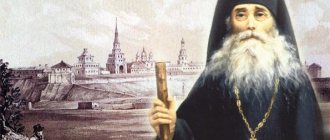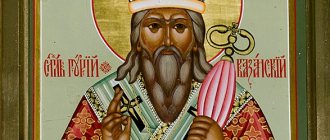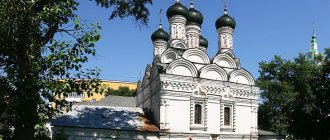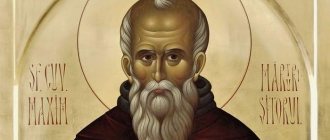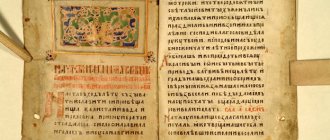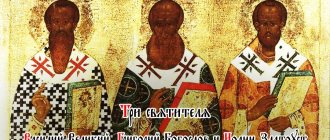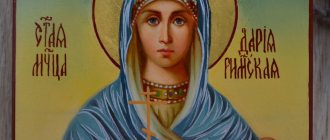| St. Barsanuphius of Kazan |
Barsanuphius of Kazan
(c. 1495 - 1576), Bishop of Tver, miracle worker, saint Commemorated April 11, October 4 for the transfer of relics [1], in the Cathedrals of Kazan and Tver Saints
In the world, John was born around 1495 in the city of Serpukhov in the family of the priest Vasily. Distinguished by his hard work and understanding, the youth easily mastered reading and writing, mastered reading the Psalter and church singing to such an extent that he could not only read and sing himself, but also help others.
In May 1512, the Crimean Horde, led by princes Akhmat and Burnash, sons of Khan Mengli-Girey, attacked Serpukhov and Varsanuphius, a seventeen-year-old youth, was captured. He was taken to Crimea and sold into slavery. In severe trials he had to endure a lot, but, trusting in the Lord, the future saint lived as a novice in a monastery, learning obedience, kindness and patience. He slept and ate little, was distinguished by his zeal and meekness, worked without contradiction, and therefore won over the hardened hearts of the Gentiles. Gradually, he mastered the spoken Tatar language to such an extent that after two years he could not only speak well, but also write in Tatar.
The captivity lasted three years. With great difficulty, having collected the necessary amount, priest Vasily ransomed his son from there. Blessed John returned home. According to the unshakable decision that matured in the soul of the young man while still in captivity, he went to Moscow, where he took monastic vows at the Spassky Andronikov Monastery, making vows of virginity, obedience and non-covetousness to God. The newly tonsured monk was named Barsanuphius.
With a strict and godly life, he succeeded in deeds of virtue and prayer. At the monastery he met Saint Akakios, Bishop of Tver, who predicted that Barsanuphius would be his successor at the see.
In 1544, with the blessing of Metropolitan Macarius of Moscow, he was installed as abbot of the Nikolsky Pesnoshsky Monastery.
In 1553, on the way to the Kirillov Monastery, the Pesnosh monastery was visited by Tsar John Vasilyevich, who drew attention to the experienced abbot, an expert in the Tatar language and customs. In 1555, elevated to the rank of archimandrite, together with the saints Archbishop Gury and Archimandrite Herman, he was sent to the newly established Kazan diocese to found a monastery. On July 31 (or 27) of the same year he arrived in Kazan together with the monks of the Pesnosha Monastery Tikhon, Theodorit, Job, Andronik and Sylvester, as well as the monk of the Andronikov Monastery Simeon. With the help of the sovereign, around 1557 the brethren founded the Kazan Transfiguration Monastery. Soon, Archimandrite Barsanuphius consecrated the first monastery church - St. Nicholas, and a little later - the Transfiguration Cathedral. The monastery was equipped with extensive estates and grew rapidly, being organized according to the charter drawn up by Barsanuphius [2]. Thanks to his knowledge of Tatar, Barsanuphius zealously preached the Gospel to the Tatars. The saint wore chains secretly from everyone. Thanks to his ability to heal mental and physical illnesses, his name became known far beyond the borders of Kazan; many sick people who came to him for healing converted to Christianity. On December 2, 1563, he was tonsured into the great schema, and on December 5, he performed the funeral service for St. Gury of Kazan.
In 1567, Saint Philip, Metropolitan of Moscow, summoned Saint Barsanuphius to Moscow and consecrated him Bishop of Tver and Kashin. In the same year he consecrated the Ascension Church in the Orshina Monastery. Despite his episcopal rank, he remained the humble ascetic he had been before. He spent his days in labor, his nights in prayer, while resting he sewed hoods, which he gave to monks and bishops. With unceasing prayer he healed the physical and mental illnesses of those who turned to him.
His priesthood in Tver occurred during the troubled years of the oprichnina. In 1569, Saint Philip, languishing in prison on the Tver land, in the Otroch Monastery, was deprived of his life by Malyuta Skuratov. Saint Barsanuphius was not allowed to know about his death and the body of Saint Philip was buried in the presence of Malyuta.
Dejected by old age and physical ailments, he retired in 1570 and returned to the Kazan Transfiguration Monastery, which he founded, where he died on April 11, 1576 [3]. The saint was buried by Kazan Archbishop Tikhon at the altar of the Transfiguration Cathedral, next to St. Gury.
What holiday is it today?
July 24, 2021, Saturday
Today are holidays, events: Events that happened on July 24 in the world, in various years Tomorrow: Memorial Day of Vladimir Vysotsky Day of St. Christopher (patron saint of motorists and traffic police)
Today is an Orthodox holiday: Great Martyr Euphemia All-Praised. Equal to the Apostles Grand Duchess Olga of Russia, in holy baptism Helena. St. Arkady of Vyazemsky, Novotorzhsky... Tomorrow: Martyrs Proclus and Hilary. Reverend Mikhail Malein. Venerable Arseny of Novgorod. Venerable Martyr Simon of Volomsk...
Today is a national holiday: Efimya Stozharnitsa. Olga Stradnitsa... Tomorrow: Proclus the Mourner...
Seasons
Seasons, four periods of the year (spring, summer, autumn and winter) characterized by certain average temperatures. The period during which the Sun passes through one of these sectors is called the season. Spring in the Northern Hemisphere and autumn in the Southern Hemisphere begin when the Sun passes through the initial circle of declination and its right ascension is 0° (vernal equinox). Summer in the Northern Hemisphere and winter in the Southern Hemisphere occur when the sun's right ascension is 90° (summer solstice). Autumn in the Northern Hemisphere and spring in the Southern Hemisphere begin when the sun's right ascension is 180° (autumnal equinox). The beginning of winter in the Northern Hemisphere and summer in the Southern Hemisphere is considered to be the winter solstice, when the direct ascension of the Sun is 270°... Next: Seasons. Russian folk calendar. Monthly words...
Folk calendar about every day
Every day one season always replaces another and this determines a person’s way of life. In connection with this, a folk calendar was formed in which there were practically no nameless, unmarked days. Every day was special, had its own purpose. All this was determined by climate conditions and astrological phenomena.
A calendar is a system for counting periods of time. The first calendars arose a long time ago, in ancient times, because there was a need to measure time. The word calendar comes from the Latin words caleo - to proclaim and calendarium - debt book. This is due to the fact that in Ancient Rome the beginning of each month was especially proclaimed, and because it was customary to pay debts on the first day of the month. Different peoples counted time differently. Some calendars are based on the changing phases of the moon - lunar calendars; in others - the change of seasons - sunny; in others, the length of the year was coordinated with the change of seasons, and the counting of months was associated with the phases of the Moon. Such calendars are called lunisolar.
In Rus', the calendar was called a monthly calendar. Every day, the month book covered the entire year of peasant life, “describing” day by day, month after month, where each day had its own holidays or weekdays, customs and superstitions, traditions and rituals, natural signs and phenomena. The cyclical nature of the calendar is reminiscent of human life, where spring is youth, summer is heyday, autumn is the time of harvesting fruits (it’s good if there are some, otherwise you can live your life without collecting fruits), winter is the time of wisdom and peace. This cyclicality and rhythm determined the way of life of the farmer. The folk calendar was an agricultural calendar, which was reflected in the names of the months, folk signs, rituals and customs. Even the determination of the timing and duration of the seasons is associated with real climatic conditions. Hence the discrepancy between the names of the months in different areas... Next: Folk calendar...
The spiritual path of the saint
The future saint was born in 1845 in Samara, his father was a wealthy man and was engaged in trade. The mother died early, but the stepmother turned out to be a loving and pious woman who instilled in the boy a love for the Lord. Pavel Plikhankov (name Barsanuphius in the world) graduated from a military gymnasium, and then a college, made a career in the army, and held the rank of colonel. He had the opportunity to continue to live in a secular society, but he abandoned all these imaginary benefits.
Venerable Barsanuphius of Optina
When Pavel Plikhankov was 46 years old, fate brought him to the small ancient monastery of I. Baptist. Here he fell in love with praying in front of the shrine with the remains of St. Barsanuphius of Kazan, wonderworker and bishop of Tver. Gradually, the thought of entering monasticism began to ripen in his mind.
- His choice fell on the legendary Optina Hermitage, where Elder Ambrose, famous for his gift of clairvoyance and miracle-working, was staying at that time. The saint met Pavel Plikhankov and said that he would accept him into the monastery only in two years. As time passed, the colonel asked to resign, arrived at the monastery, but did not find Saint Ambrose alive. The former military man was enrolled among the brethren in 1892, eight years later he was tonsured and given the name Barsanuphius. He became a hieromonk in 1903.
- During the Russian-Japanese War, the monk went to the front, where he confessed, gave communion and unction to dying soldiers, without fear of death from bullets wandering nearby. At the end of the conflict, Barsanuphius returned to spiritual activity and in 1907 received the rank of abbot. By this time, the fame of the venerable Optina elder had spread throughout the Fatherland.
Interesting! The Orthodox people, sensing the approach of terrible events, sought to receive the elder’s blessing and forgiveness of sins. The saint healed those who were sick in body and those whose souls were completely mired in sins, directed them to the path of humility and revealed the innermost essence in people.
- Only a few times during his long life did the Monk Barsanuphius leave the Optina monastery. In 1910 he went to see the dying L. Tolstoy. The saint noted that the writer was unable to penetrate the spirit of monasticism because he tightly bound himself with the bonds of a materialistic vision of the world. Some monks were dissatisfied with the way the Monk Barsanuphius carried out his affairs. Basically, his opponents were monks of the new era, who came to the monastery from a spiritually degraded people. After some time, the elder was removed from Optina, despite the fact that for a long time he tried to persuade him to leave him at least as a simple novice.
- In 1912, the monk was appointed rector of the neglected and unkempt Old Golutvina Epiphany Monastery, on the outskirts of Kolomna. Here the elder courageously endured the sadness of separation from his native desert, trying to restore the territory entrusted to him. The people continued to flock to the elder’s hut to receive wise instruction. The saint continued to receive people and listen to their confessions, despite the fact that he himself was exhausted from numerous illnesses of the body. He did not refuse anyone, he accepted everyone with great love and cordiality.
Old Golutvinsky Monastery, Kolomna, Moscow region
Vasanuphiy ruled the Staro-Golutvin Monastery for a little less than one year. Before his death, the monk experienced terrible torment. He refused any medical help, insisting that he be left alone, because his body was already on the cross.
In his last days, the elder received communion tirelessly; his soul went to the Lord in the spring of 1914. The saint was buried in the Optina Hermitage, next to his spiritual mentor Anatoly.
Fishing calendar for every day
The fishing calendar should not be taken as an absolutely indisputable truth. Fish biting is greatly influenced by a whole range of natural factors, as well as the influence on the nature of man himself. You must not forget that the fish’s bite depends and is determined not only by the calendar dates and biological cycles of their life, reflected in the calendar, but also, no less, by the state of their habitat; the bite also depends on weather conditions: air and water temperatures, cloudiness, wind direction and strength, etc... Next: Fishing calendar...
Lives of Saints Guria and Barsanuphius, Kazan Wonderworkers*
In the years of the pious and Christ-loving autocrat of the Russian land, Grand Duke Vasily Vasilyevich of All Russia, under His Holiness Metropolitan Photius of Kiev and All Russia. When God wants to glorify His saint, the lamp does not exist underground, but is visible to all. And this happened according to some order of God. The weight of the church collapsed during the Divine Liturgy; the priest is still in the altars. But by the grace of L. 358 rpm
.
Through Christ and the prayer of his saint, the Holy Wonderworker, Metropolitan Alexy, everyone was preserved unharmed. And having cleared that place, I wanted to build a new church again. And they began to dig ditches into the foundation of the church, and they found the body of blessed Alexis intact and unharmed, and his vestments had not decayed. Oh, great miracle! so much of the summer has passed and the saint lies in the tomb - his holy body and his vestments have not changed, as if yesterday they were clothed; Therefore, may what was spoken by God in the Holy Gospel be fulfilled: “a city cannot hide on top of a standing mountain, and no one has lit a lamp .”
359 .
places it in a hidden place,” or under a bed (Matt. 5:14–15). Likewise, the lamp itself is not powerful enough to remain hidden underground for so many years; All this was the providence of the all-wise God. As soon as they heard the discovery of the Holy One, and hearing this, the blessed and Christ-loving Prince Vasily Vasilyevich and all the faithful princes - soon came to a wondrous miracle and to the finding of the Holy Body and with His Holiness Photius, Metropolitan of Kiev and All Russia, and with him the bishops and celebrants , the entire church rite came with psalms and singing and candles and from the chandelier, giving great praise to Almighty God l.
359 rev . and his saint the Wonderworker Alexy.
The people of Muscovy flocked with joy to see his honest and holy body. The faithful and great prince Vasily Vasilyevich of all Russia and all the noble princes came - having seen such the glory of God and bowed to the Holy and divine body of our venerable father Alexei and rejoiced greatly with great joy; and, sighing from the depths of his heart, saying: “I praise and glorify You, Lord my God and Your Most Pure and Immaculate Mother, as You have vouchsafed me Your servant in my years to see such a treasure and goodness .” 360
.
My powers will appear to me. As if You have given us a second source of grace in our city of Moscow, which works for us wondrous miracles for our last generation, not only for our only city, but for the whole city and country that flows in with faith. But such are the wondrous miracles and gifts of Thy mercy to receive, O Master, for I have already been blasphemed by God’s grace from all the Holy men. Oh, Most Holy Our Saint, Wonderworker Peter, and Holy Hierarch of Christ, Reverend Our Father, Wonderworker Alexei! do not stop praying to God for us and for all your faithful servants; you are an ambulance l.
360 rpm
helper and protector of our land Rusti and an insurmountable wall to our native city Moscow.” The great Christ-loving prince and all with him the noble princes and bolyars and their nobles and all the Muscovite peoples kissed his holy body kindly. And for this reason the church was erected quickly, extremely beautiful, for God’s sake. And our Lady Theotokos placed the holy body in the race at the border of the honorable Annunciation, in the right land, where his holy relics are visible to this day, abundantly giving healing to everyone; His relics were brought in the month of May on the 20th day, in memory of St. Martyr Faliley, may he not remain silent .
361. but the truth will be, and let the righteous be said: “Elma, for God glorifies not only in the life of those who glorify him, but also after death he showed many different miracles, about which let a few be spoken of many.”
The story is useful, as if it is close to the eyes: but bewilderment and poverty of reason, like a bird soaring through the air, creates the furthest thing from our mind. But above all, relying on the many bounties of the Son of God, our Lord and God and Savior Christ Jesus, and on the prayers of his venerable saints, both the king for the sake of command, and the bishop for the sake of blessing, I dared to touch the charter and the cane. Even if the father had not found these holy hierarchs and saints from infancy, those who knew their lives and their fatherland are known: but otherwise, having heard from those who knew, I dared to write this. The first person to witness the discovery of their holy and miraculous incorruptible relics was to see with his own hands their holy and miraculous relics first of all; Moreover, during the discovery of their honest relics, the voice of someone was heard again. From the voice this word came: “In the city of the present, the Lord surprises His saints.”
Moreover, let this also be remembered: for while this holy Saint Barsanuphius is still alive, to a certain cleric living in the world, the speech of a certain clairvoyant ambassador with his spiritual father followed and came true according to the prophecy of the saint; Saint Barsanuphius was living then in the city of Kazan in the monastery created by him, of the Holy God-beautiful Transfiguration of the Savior, leaving the flock of the Tpher throne. Moreover, it was also indecent for me to happen in that holy monastery, to be fifth after him, and to stand in his place, and to hold his staff in my hand. God willing, even if someone were to view this matter with me, I am afraid of this, and it is disgusting from many: otherwise we would not turn on such a great and notorious name, not just the matter; but both stood in the place of Saint Guria, and carried his staff in my hand as well, the number nine from the first, and the first in name. And I remembered all this, and judged myself: if I do not dare to touch the story, I am afraid of the condemnation of the lazy servant, who took his master’s money, and did not make a purchase, as the very truth of the speech of the Lord and our God; and again in the second law: “You shall not appear,” he said, “before the Lord... empty” (Deut. 16:16), but each one shall bear the gift; to the great Vasily saying: “He was appointed to build the word, and is not heedless about this, as if a murderer is being tried”; the great theological Gregory says: “For it is dishonor to remain silent, about which there is a need to speak”; John Chrysostom, who is many and great in his words: “If I keep my word and don’t give it, then I am poor; if I give it, I will be richer; if I don’t give it, I am the only one richer; if I give it, I will bear joyful fruit.” Just as a scribe’s cane is idle without a writer, so an archer’s arrow is immovable without a drawer and requires an assistant; or like a horse, if someone does not strike, he is idle and idle: so we too, if we leave the story of these saints to write, about the discovery of their honest and miraculous relics, and many miracles, we will be idle and idle, and with the lazy slave the same Let's meet again. Otherwise, it is not my haste or strength, but all human correction comes from God; For the Lord himself says: “For without Me you can do nothing” (John 15:5). We are great, and we will bring it to the glory of God and the praise of the saints.
Orthodox calendar about every day
Orthodox calendar: Orthodox, Church and Christian holidays.
The church year is an alternation of weekdays and holidays. On weekdays, a person is called to work “by the sweat of his brow to earn his bread.” Holidays are given in order to feel liberation, to rise above the bustle and routine of the world, to feel involved in the highest of worlds, “where there are no illnesses, sorrows and sighs, but endless life.” Since ancient times, holiday cycles have been associated with the seasons. The pagans associated them with the worship of the forces of nature, the cult of which in the Old Testament was replaced by gratitude to the Creator for the universe. And although the connection between holidays and the seasons has not completely lost its power, since God is present in everything, in the plant and animal world, in human works, it nevertheless faded into the background, giving way to a spiritual foundation built on the Sacred Scriptures. The history of Orthodox holidays dates back to the times of the Old Testament. Each of the Orthodox holidays is dedicated to the remembrance of the most important events in the life of Jesus Christ and the Mother of God, as well as the memory of saints... Next: Orthodox calendar...
Documents, literature
- PSRL. T. 4. P. 309; T. 19. M., 2000. Stb. 482; T. 31. M., 1968. S. 141, 146.
- Platon (Lyubarsky), archbishop. Kazan Sat. Art. Kaz., 1868. P. 7-32.
- Hermogenes, Patr. Moscow and all Russia. Creations. M., 1912.
- Barsukov. Sources of hagiography. pp. 141-143.
- Church antiquities of Kazan // Izv. for the Kazan diocese. Kaz., 1877. P. 408-409.
- Nevostruev K. [I.] List from scribe books for the city of Kazan with the district for 1566-1568. Kaz., 1877. P. 31.
- The art of Stroganov masters: Restoration. Research Problem: Cat. vyst. M., 1991. P. 162. No. 108.
- Silkin A.V. Stroganov face sewing. M., 2002. P. 278, No. 88; P. 282, No. 87; P. 296, No. 95; P. 326, No. 129.
- Eliseev G. Z. Biography of St. Guria, Herman and Barsanuphius of Kazan and Sviyazhsk miracle workers. Kaz., 1847.
- [Grigory (Postnikov), archbishop]. Life of St. and Wonderworkers Guria Archbishop. Kazansky and Barsanuphius Archbishop. Tverskoy. St. Petersburg, 1853.
- Stroev. Lists of hierarchs. pp. 216, 442.
- Rudnev V. St. Barsanuphius as abbot of the Nikolaev Pesnosha Monastery. M., 1889.
- [Dimitri (Sambikin), archbishop]. Tver Patericon. Kaz., 1907. P. 81-84.
- Nikanor (Kamensky), archbishop. Life of St. Barsanuphia // Kazan collection. Art. Kaz., 1910.
- Macarius. History of the RC. Book 6. P. 56, 88, 139, 587. Note. 93, 617. Note. 174.
- Lebedev E.M. Spassky Monastery in Kazan. Kaz., 1895.
- Batalov A. L. Mosk. stone architecture XVI century M., 1996. pp. 44-45.
Russian folk calendar for every day
The word “sign” comes from the word “notice”, i.e. observe. As a result of observing what happens around a person every day, he accumulates life experience. This knowledge was passed down from generation to generation, carefully preserved and people trusted it as a sacred book. Many signs have come to us from the depths of centuries without losing their knowledge. Each of us is free to choose: to dismiss all this as an absurd superstition or to take a closer look at the signs and take the centuries-old experience of generations more seriously. Most of us, when taking exams, ask them to scold them, boasting about some kind of good fortune or luck, spit so as not to jinx them or knock on wood, take a detour if a black cat crossed the road, are afraid of the number 13 and much more. And who among us does not have lucky things, numbers? Who has never resorted to the help of fate at least once in their life, who has not believed in secrets? It’s as if everything connected with signs is hidden somewhere deep in our subconscious. Often we remember them mechanically, unconsciously, or just as a joke. But, undoubtedly, the signs contain a lot of accurate knowledge and practical wisdom of our ancestors. They cover all the characteristic, often difficult to perceive, natural phenomena. Signs have preserved a lot of what was in old folk holidays and customs; they help predict the weather, grow crops... Next: Folk signs...
Gifts from God
Barsanuphius received from the Lord the gift of clairvoyance and was not inferior in this to the other elders of the desert. God revealed to him all three times in the lives of people who came to him for help. The saint saw the soul as a canvas, so it was easier for him to guide the layman on the righteous path, heal illnesses, and cast out demons. The elder owed this gift to his continuous commitment to spiritual achievement through prayer addressed directly to the Creator.
Witnesses claimed that Barsanuphius was embraced by divine flames when the liturgy was celebrated in the desert.
- One day, the daughter of a rich landowner turned to a good-natured righteous man with a request to bless her for a good marriage. The elder informed her that she would receive the best groom she could think of. Over the course of a year, the girl met interesting and handsome men, but things did not go beyond friendly relations. During the Civil War, she moved with her parents to another city. On the way, the girl fell ill with typhus and died. Before her death, she managed to partake of the Holy Mysteries and find Christ, her groom.
- When Sofya Lopukhina was still a 16-year-old girl, her parents took her with them to Optina Pustyn. Elder Barsanuphius noticed the child, called him to him and told her in detail what awaited her in life, down to the smallest detail. The second time Sophia saw the saint was when he stopped in Moscow, heading to the Golutvinsky Monastery. The woman received as a gift the icon of the “Kazan” Mother of God, which Barsanuphius himself bequeathed to her after his death. Sofia Lopukhina never parted with this sacred relic, reminiscent of the foresight of the venerable saint.
Icon of Barsanuphius of Optina - Those close to the Monk Barsanuphius more than once saw how the saint drove demons out of the bodies of unfortunate sufferers. In the most difficult cases, the elder had to spend a colossal amount of his own life energy in order to save a person from the wrath of Satan. The possessed resisted healing for a long time, reviled the saint with unbearable abuse, shook in frantic rage, calling him an ordinary colonel and wanting to tear his flesh to pieces. However, the saint always won such battles with demons, without sparing himself.
In his last will, the reverend father asked that his friends and relatives forgive him for his sins. The saint noted that he acted within the framework of preserving the divine covenants and institutions of the ancient ascetics. Barsanuphius repented that he was imperfect and asked his spiritual children to follow the instructions of wisdom and righteousness.
He especially emphasized:
“The unquenchable practice of prayer and reading the Holy Scriptures will certainly help in the matter of enlightenment and achievement of the Kingdom of Heaven. Avoiding virtue and righteousness is worse than accepting a thousand deaths. It is necessary to show courage in spiritual exploits, even if hell itself rises up against the soul.”
Holiday calendar, dates and events of the year
All state and professional holidays in Russia, including significant World and International holidays, and other equally interesting holidays and events about every day.
The holiday has always kept pace with the history of mankind. Social time can be divided into three types: everyday life (weekdays), weekends and holidays. Everyday life is a series of practices repeated day after day and every day (work). Weekends are regular breaks from the rush of everyday life. It is believed that on weekends a person should restore his strength after working days. Day off, non-working day. A holiday is a day of celebration established in honor or in memory of someone or something. A day or series of days celebrated by the church in memory of a religious event or saint... Next: Calendar...
Prayer book, Orthodox prayers for every day
Prayer is the most powerful means for healing all illnesses - both physical and mental. Prayers can be laudatory or grateful, petitionary and repentant. If we have offended God, sinned, we must ask Him for forgiveness, that is, repent. Such prayers are called repentant prayers. If everything is fine with us, if we and our loved ones are healthy and prosperous, if we have a place to live, something to wear, something to eat, we must glorify and thank God for this. Such prayers are called praise or thanksgiving. If some misfortune, illness, trouble or need happens, you need to ask God for help. Such prayers are called petitionary... Next: Orthodox prayers...
Zodiac, astrological, eastern calendar. Zodiac signs
In ancient times, to establish the calendar, priests used knowledge of the positions of all the planets. Before the reform of Peter 1, the New Year was celebrated on the Day of the Autumn Equinox. On this day, according to ancient legend, the most peaceful treaty was concluded between the Great Race (ancient Slavs) and the Great Dragon (ancient Chinese) and it was approximately 7518 years ago... For the ancient Slavs, the calendar month corresponded to the lunar cycle from new moon to new moon, taking into account such Thus, the relationship of the entire annual cycle with astronomical and natural phenomena. There was no coherent calendar system. The main natural phenomena are still considered to this day to be the days of the solar equinox and solstice - the Slavic holidays Maslenitsa, Kupala, Ovsen and Kolyada. But during the time of Peter 1, all ancient Slavic calendars were abolished and a new Western European calendar from the Nativity of Christ (Julian calendar) was introduced, while the beginning of the calendar was moved to January 1. The Julian calendar (old style) did not take leap days into account and accumulated one extra day every 128 years. After the October Revolution in 1918, the Gregorian calendar (new style) was introduced in Russia, according to which an amendment of 13 days was introduced. The calendar of the ancient Slavs was based on two planets: the Sun and the Moon. And now they don’t use anything at all. The calendar has become static. There is no such thing as the calendar, it turns out, resting on some planet. Nobody even knows about it. There are just some standard numbers, there are months and holidays. The calendar is based on the Sun and Moon. Why is this so? Because these two luminaries influence the Earth. The Earth revolves around the Sun, and the Moon revolves around the Earth. And these two luminaries create the atmosphere on the planet. From here the calendar is built... Next: Astrological calendar...
VARSONOPHIUS
V. served in Kazan first as an archimandrite, his images in a phelonion and a monastic doll are found in the miniatures of the front Lives of Guria and V. Usually he is depicted as a saint in accordance with the descriptions in the iconographic originals: “in a hat, a saint’s robe, an omophorion and a Gospel,” "in felonies and omophorions." The iconography is close to the image of the archbishop. Kazansky Guria: “overbeard, brada like Guriev” with the difference in the shape of the beard - “at the end it forked” (this feature is sometimes not visible in the images). V. - “a very old man of the Russian type, gray-haired with darkness, a narrow and long beard, simple hair... you can write him in the schema” (Filimonov. Iconographic original. P. 166; Bolshakov. Iconographic original. P. 36; Guide to writing icons of the holy saints of God in the order of the days of the year: Experience of a manual for icon painters / Compiled by V. D. Fartusov. M., 1910, 2002. P. 36).
In the Transfiguration Cathedral of the Spaso-Preobrazhensky Monastery (not preserved), founded by Archim. V. in the Kazan Kremlin, there was an ancient (?) altarpiece double-sided icon “Our Lady of Tikhvin - Saints Gurias and Barsanuphius” in a basma frame, with chased crowns and bezels, decorated with pendants with precious stones and pearls. From those that have survived to this day. From the time of the description of the icon, it follows that “the images of the saints are very characteristic and are distinguished by the rigor of the ancient icon painting style. The saints are dressed in ancient long phelonions with white narrow omophorions, and low hats with white ermine trim. Saint in stature. Gury is more holy. Barsanuphia... At St. Barsanuphius's face is thin, emaciated, his cheeks are deeply sunken, his beard is long, but sparse and ends about half of his chest - it is somewhat smaller than the saint's beard. Houri. Saints have eyebrows. Barsanuphia is wider, his mustache is thinner and allows one to see large lips, there is less gray in his beard, his eyes look more sternly” (Zarinsky P., Archpriest. Church antiquities of Kazan. 1. Kazan Spaso-Preobrazhensky Monastery // Reports on the Kazan diocese. 1877. No. 14. P. 403).
The earliest known image of V. is on the right margin of the embroidered shroud “Our Lady of Kazan” (early 17th century, Russian Museum), the iconography of the middle cut goes back to the icon revealed in 1579 in Kazan; V. in a phelonion, omophorion, low miter, the right hand is raised in a two-fingered blessing, in the left is the Gospel, above the figure is the inscription: “St. Barsanuphius the Wonderworker”; in the left field is the archbishop. Gury. On icons of the Mother of God of Kazan, the figures of Saints V. and Guria are often placed in the margins: on the right field of the Vologda icon from the Spaso-Prilutsky Monastery (1st quarter of the 17th century, VGIAHMZ; 2nd quarter of the 17th century dated to: Rybakov A. Vologda icon. Centers of artistic culture of the land of Vologda XIII-XVIII centuries. M., 1995. Cat. 122, 123) depicts V. with an elongated wedge-shaped beard, with his hand raised in blessing, with the Gospel; on icons of the XVI(?)-XIX centuries, XVII centuries. (copybooks) (both in SPGIAHMZ) and 19th century. (GMIIRT); sometimes Gury and V. are depicted kneeling on the lower field of the icon of the 17th (?) - 19th centuries. (SPGIAHMZ). Saints Gury and V. were also depicted on the sections of the icon cases of the Kazan Icon of the Mother of God (for example, the icon case from the Nizhny Novgorod lands mentioned in 1627 - Pavlovich G. A. Kazan Icon of the Mother of God and the Kazan Cathedral on Red Square // Culture of the Middle Ages. Moscow XIV- XVII centuries. M., 1995. S. 227-228). According to the earliest surviving inventory of 1771 of the Moscow Kazan Cathedral, above the north. by the doors stood a “calm” (approx. 31.2´ 26.7 cm) image of the Kazan Mother of God in a pearl robe and a similar icon case with doors.
Particularly popular are paired
Kazan Icon of the Mother of God with Saints Barsanuphius and Gury in the fields from the Spaso-Prilutsky Monastery in Vologda. 1st quarter XVII century (VGIAHMZ) Kazan Icon of the Mother of God with Saints Barsanuphius and Gury in the fields from the Spaso-Prilutsky Monastery in Vologda. 1st quarter XVII century (VGIAHMZ) images of Saints Guria and V. According to the same inventory, in the chapel of the Moscow Kazan Cathedral in the name of the Kazan wonderworkers Guria and V. (consecrated in 1647) there were large icons of saints (with the Savior at the top, in frame (133.4´ 93, 4 cm); “dilapidated” in the sacristy (106.7´ 80 cm)). In prayer to the blessing Christ, Saints Gury and V. are represented on the 17th century icon. (copybooks of the 19th century, TsMiAR). Often Saints Gury and V. are turned in prayer to the image of the Mother of God of Kazan: icons of the 17th-19th centuries. (GIM - with saints in the fields; YAHM; PZIKhMZ); on an embroidered shroud placed by D. A. and G. D. Stroganov in the Nizhny Novgorod Spaso-Preobrazhensky Cathedral (late 50s - 60s of the 17th century, NGIAMZ), Gury and V. in prayer are addressed to the Mother of God with Gospel in hand, along the edges of the shroud is the troparion to the saints. On a shroud from the Kazan maiden monastery, sewn in the traditions of Stroganov masters (1st half - mid-17th century, GOMRT), Saints Gury and V., full-length in three-quarter turns, in phelonions, omophorions, mitres, with The gospels on the plates (in Herman’s left hand, in V.’s right), stand before the “Sign” in prayer to the Mother of God; a troparion to the saints is embroidered along the edges of the shroud. Sometimes the saints pray in front of the Deesis, placed on the upper field (for example, an icon of the 2nd half of the 17th century, State Historical Museum). On a club embroidered with pearls, which, as follows from the inscription, was inserted by boyar Ivan Morozov into the Annunciation Cathedral of the Kazan Kremlin (1654, GOMRT), small life-size figures of blessing Gury and V. (V. below Gury) with the Gospels in their hands are located frontally on the sides of the Annunciation, at the top is the Lord of hosts, around the troparion to the Annunciation of the Virgin Mary (Donikon version) is embroidered. On the double-sided remote icon the beginning. XVIII century “Our Lady of Shuiskaya - Saints Gury and Barsanuphius” the saints stand in prayer to the Savior, below between their figures there are slides (GMZRK). In the Deesis composition, Gury and V. (turned to the left) - on an icon of the 17th-18th centuries. (YAHM), on a folding frame (with the Mother of God Hodegetria in the center) - on the sides on the wings (XVII century, State Historical Museum). Together they are also depicted on small icons decorated with silver basma (17th century, State Historical Museum).
V., together with Saints Gury and Herman, is depicted against the backdrop of the Kazan Kremlin. Several are known. such icons-piadnits beginning - 1st quarter. XVIII century (GOMRT, PGKhG): saints (from left to right Gury, V., German) with the Gospels (V. holds the Gospel with both hands), in phelonions, omophorions and miters with white edges facing to the left, in prayer to the image of the Annunciation of the Virgin Mary; below the Annunciation on all icons there are reliquaries for holy relics framed by a picturesque baroque cartouche; the Kremlin is depicted with the five-domed Annunciation Cathedral, with a porch and a bell tower behind walls with towers. On one of the icons (GOMRT) there is a more detailed image of the Kazan Kremlin: the Annunciation Cathedral is connected by a passage to the archbishop's courtyard, in the 2nd plan there are walls and towers enclosing the site of the sovereign's courtyard and the Transfiguration Monastery; on the right side of the icon behind the Kremlin walls are figures of saints standing on clouds. Sometimes on icons depicting the Kazan Kremlin, Saints Gury, V. and Herman appear in prayer to the image of the Kazan Mother of God (late 17th - early 18th centuries, Russian Museum). Their image in prayer to Christ (Deesis with those present) is on the right wing of the tricuspid fold (1st quarter of the 19th century, NTMZGD).
Among the ecumenical teachers and saints, Gury and V. are depicted frontally on the sakkos of Met. Rostov Jonah (Sysoevich), the contribution of D. A. and G. D. Stroganov to the Rostov Assumption Cathedral (1665, YaIAMZ) and on the sakkos from the Annunciation Cathedral of Solvychegodsk (c. 1665, SIHM). With the Moscow saints Herman, Gury and V. are presented on the frame of the Tikhvin Icon of the Mother of God, beginning. XVIII century from Trinity Church Sviyazhsk (GMIIRT): V. is shorter than Guria, with a narrower and longer dark beard. On Old Believer icons of the 19th-20th centuries. V. is depicted among selected saints with St. Gury, both with long narrow beards with gray hair, in low semicircular miters (GMIIRT; private collection, Kazan).
Saints Barsanuphius and Gury, Kazan miracle workers (left). Folding "Savior of Smolensk" with selected saints. XVIII century (CMiAR)
Saints Barsanuphius and Gury, Kazan miracle workers (left). Folding "Savior of Smolensk" with selected saints. XVIII century (CMiAR)
Single-figure images of V. are known on icons of the 19th - early 19th century. XX century In saintly robes ornamented with gold, a high miter, giving a name blessing, with the Gospel in his hand, V. stands frontally on an orlets, in the opening of the royal gates, on the sides there are massive columns (2nd half of the 19th century, Central Museum of Art and Culture; with this icon, according to The inscription on the back was “a copy of the original Image of St. Barsanuphius and the Wonderworker,” Archbishop of Tver Gregory blessed the Kimry merchant I. P. Malyugin). In the beginning. XX century There were icons with a half-length depiction of V. blessing a name with a massive Gospel in his hand, on a gold canthar background, with an ornament on the margins imitating colored enamels. V.'s face is executed in an academic manner with neo-Russian influence. style (CMiAR).
In copper casting, images of Saints Guria and V. in prayer are placed on the left folding door (on the right - John the Baptist and St. Nicholas) with the “Savior of Smolensk” or the Mother of God Hodegetria (both 18th century, TsMiAR), the Kazan or Passionate Mother of God in the center (XVIII, XIX centuries, TsMiAR); on individual icons in the prayer to the Mother of God “The Sign” (XVIII century, TsAK MDA). The lid of a silver gilded shrine, made in Kazan in 1834, with a relief image of the saint in a phelonion, omophorion and miter (GOMRT; photograph (c. 1941) of the shrine itself, located in the Transfiguration Monastery, is also kept in GOMRT).
Lit.: Nikolaeva T.V. Old Russian. painting of the Zagorsk Museum. M., 1977. Cat. 222, 287, 314; The art of Stroganov masters: Restoration. Research Problem: Cat. vyst. M., 1991. Cat. No. 98, 99, 108; We worship Your most pure image...: The Image of the Mother of God in the production. from collection Timing belt St. Petersburg, 1994. Cat. No. 166. Ill. us. 266; Ural icon: Picturesque, carved and cast icon XVIII - early. XX century Ekaterinburg, 1998. Cat. No. 60; Zavyalova M.K., Kargalova T.A. A brief overview of ancient Russian monuments. facial embroidery of the 16th-17th centuries. in collection GOMRT // Old Russian. artistic sewing. Materials and research. M., 1995. P. 79. Ill. 9; Inventory of church utensils and sacristy of Moscow. Kazan Cathedral 1771 / Publ., intro. Art. S. A. Smirnova // Culture of the Middle Ages. Moscow, XVII century. M., 1999. S. 390, 398-399, 407; Gnutova S. V., Zotova E. Ya. Crosses, icons, folds: Copper artistic casting XI - beginning. XX century from the collection of TsMiAR. M., 2000. Cat. 208, 210.
N. N. Chugreeva
Dream books online, interpretation of dreams
A dream book is nothing more than an interpreter of dreams and dreams, a translator of dreams. Since ancient times, people have been using dream books; dreams have always been given great importance, and people have often noticed the prophetic properties of some dreams. The dream book can become your faithful assistant every day and throughout your life, thanks to the dream interpreter you can always make the right decisions, the dream book will help you resist temptations in time, and will warn you against wrong steps and frivolous actions. Further…
